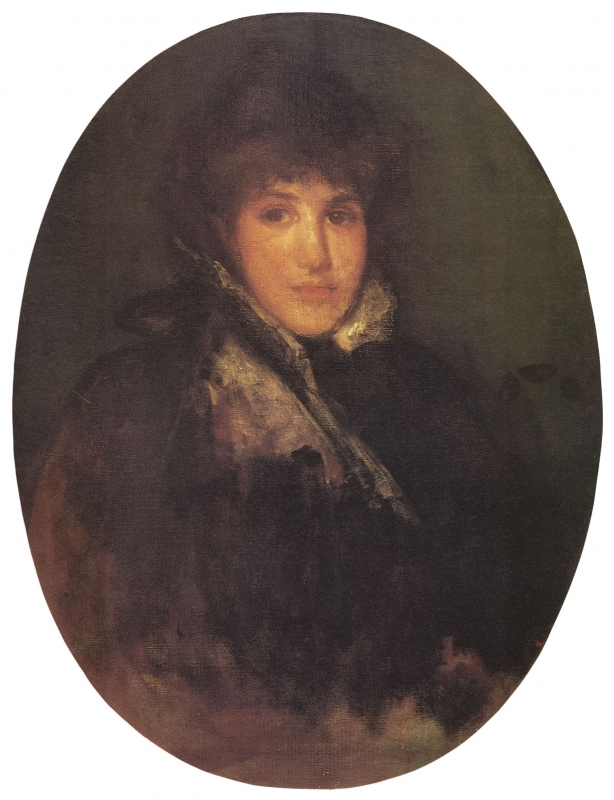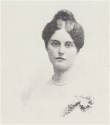Titles
Several possible titles have been suggested:
- 'The Widow' (1905, ISSPG). 1
- 'Portrait of a Lady' (1909, Worcester Art Museum). 2
- 'The Widow' (1952, Parke-Bernet). 3
- 'The Widow' (1980, YMSM). 4
It has been decided to stick with the 1905 title, 'The Widow', to avoid confusion.
Description
A half-length portrait of a woman, in oval format. She has dark curly hair, and looks directly at the viewer. She is turned very slightly to her left, and is lit from the left. She wears a dark jacket with a stand-up collar lined with white.
Sitter
The sitter has not been identified. It is not known if she was really a widow, but she is wearing black.
Andrew McLaren Young (1913-1975) suggested it was a portrait of Whistler's wife Beatrice Philip (Mrs E. W. Godwin, Mrs J. McN. Whistler) (1857-1896), painted shortly after the death of her first husband, the architect Edward William Godwin (1833-1886). 5 The Glasgow University Library possesses a photograph of Beatrice, and there are several lithographs of her including Beatrix Whistler c080. The features and short curly hair in this oil portrait are not sufficient to confirm this identification.
It looks very different from Whistler's earlier portrait of Beatrice, started during Godwin's lifetime, Harmony in Red: Lamplight [YMSM 253].
A date of 1895/1900, suggested by the technique and butterfly, does not entirely preclude the identification of the sitter as Beatrice Whistler (who died in 1896) but makes it less likely. In 1895-1896 she was very ill indeed – which would not fit the warm and alert expression of the sitter in this portrait – and she was no longer a widow. Finally it would seem most unlikely that Whistler would have parted with a portrait of his wife after her death.
Another, rather faint possibility is, that it is a portrait of Magda Stuart Sindici (Mrs W. Heinemann) (b. 1878, m. 1899), who posed for an oval portrait in 1900. This portrait was left incomplete after her divorce from William Heinemann (1863-1920), and has not been located.
Comments
Henniker-Heaton commented, in the Worcester catalogue of 1922:
'The chief merit is in the quality of the painting. There is no psychological penetration in the artist's attitude, no message of great volume. The very title may imply a sentimental attitude on the part of the painter. But, if there is any such attitude, it is subconscious, and the figure is but an object for the use of a sensitive brush. Any sentiment the subject may have inspired expresses itself more in the quality of brush-work than in any intentional infusion of literary interest.' 6
Notes:
1: Memorial Exhibition of the Works of the late James McNeill Whistler, First President of The International Society of Sculptors, Painters and Gravers, New Gallery, Regent Street, London, 1905 (cat. no. 1).
2: [Exhibition], Worcester Art Museum, Worcester, MA, 1909 (cat. no. 32).
3: Parke-Bernet, New York, 21 May 1952 (lot 38).
4: YMSM 1980 [more] (cat. no. 459).
5: A. McL. Young to Dr W. S. Serri, 16 September 1972, GUL WPP file.
Last updated: 3rd January 2021 by Margaret








